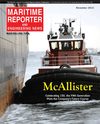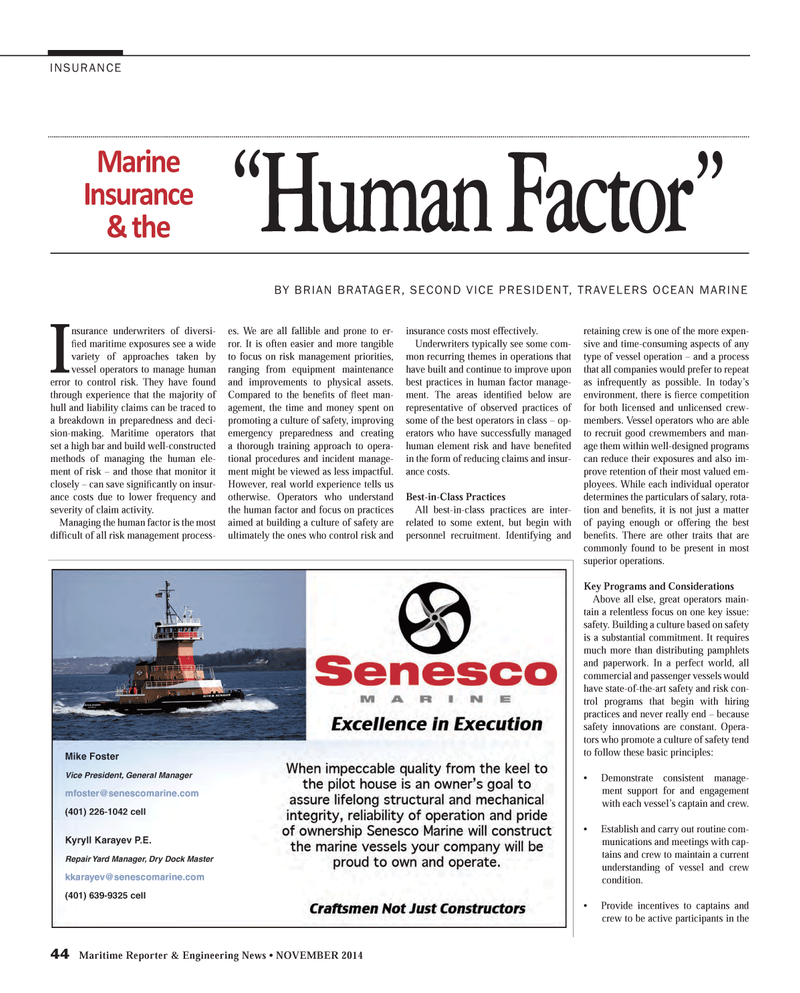
Page 44: of Maritime Reporter Magazine (November 2014)
Workboat Edition
Read this page in Pdf, Flash or Html5 edition of November 2014 Maritime Reporter Magazine
44 Maritime Reporter & Engineering News • NOVEMBER 2014
INSURANCE
I nsurance underwriters of diversi- ? ed maritime exposures see a wide variety of approaches taken by vessel operators to manage human error to control risk. They have found through experience that the majority of hull and liability claims can be traced to a breakdown in preparedness and deci- sion-making. Maritime operators that set a high bar and build well-constructed methods of managing the human ele- ment of risk – and those that monitor it closely – can save signi? cantly on insur- ance costs due to lower frequency and severity of claim activity.
Managing the human factor is the most dif? cult of all risk management process- es. We are all fallible and prone to er- ror. It is often easier and more tangible to focus on risk management priorities, ranging from equipment maintenance and improvements to physical assets.
Compared to the bene? ts of ? eet man- agement, the time and money spent on promoting a culture of safety, improving emergency preparedness and creating a thorough training approach to opera- tional procedures and incident manage- ment might be viewed as less impactful.
However, real world experience tells us otherwise. Operators who understand the human factor and focus on practices aimed at building a culture of safety are ultimately the ones who control risk and insurance costs most effectively.
Underwriters typically see some com- mon recurring themes in operations that have built and continue to improve upon best practices in human factor manage- ment. The areas identi? ed below are representative of observed practices of some of the best operators in class – op- erators who have successfully managed human element risk and have bene? ted in the form of reducing claims and insur- ance costs.
Best-in-Class Practices
All best-in-class practices are inter- related to some extent, but begin with personnel recruitment. Identifying and retaining crew is one of the more expen- sive and time-consuming aspects of any type of vessel operation – and a process that all companies would prefer to repeat as infrequently as possible. In today’s environment, there is ? erce competition for both licensed and unlicensed crew- members. Vessel operators who are able to recruit good crewmembers and man- age them within well-designed programs can reduce their exposures and also im- prove retention of their most valued em- ployees. While each individual operator determines the particulars of salary, rota- tion and bene? ts, it is not just a matter of paying enough or offering the best bene? ts. There are other traits that are commonly found to be present in most superior operations.
Key Programs and Considerations
Above all else, great operators main- tain a relentless focus on one key issue: safety. Building a culture based on safety is a substantial commitment. It requires much more than distributing pamphlets and paperwork. In a perfect world, all commercial and passenger vessels would have state-of-the-art safety and risk con- trol programs that begin with hiring practices and never really end – because safety innovations are constant. Opera- tors who promote a culture of safety tend to follow these basic principles: • Demonstrate consistent manage- ment support for and engagement with each vessel’s captain and crew. • Establish and carry out routine com- munications and meetings with cap- tains and crew to maintain a current understanding of vessel and crew condition. • Provide incentives to captains and crew to be active participants in the “Human Factor”
Marine
Insurance & the
BY BRIAN BRATAGER, SECOND VICE PRESIDENT, TRAVELERS OCEAN MARINE
Mike Foster
Vice President, General Manager [email protected] (401) 226-1042 cell
Kyryll Karayev P.E.
Repair Yard Manager, Dry Dock Master [email protected] (401) 639-9325 cell
MR #11 (42-49).indd 44 10/28/2014 10:39:52 AM

 43
43

 45
45
